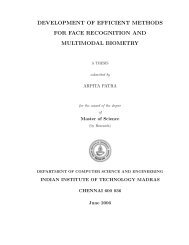The Enigma of Group Theory - Department of Computer Science ...
The Enigma of Group Theory - Department of Computer Science ...
The Enigma of Group Theory - Department of Computer Science ...
Create successful ePaper yourself
Turn your PDF publications into a flip-book with our unique Google optimized e-Paper software.
http://www.cs.bris.ac.uk University <strong>of</strong> Bristol, <strong>Department</strong> <strong>of</strong> <strong>Computer</strong> <strong>Science</strong><br />
Notice, how i3 is stepped on every 650 = 26 · 25 iterations whilst i2 is stepped on every 26 iterations and<br />
also stepped on an extra notch every 650 iterations. We can now present ɛj as<br />
ɛj = τ · (σ i1+j ρ1σ −i1−j ) · (σ i2 ρ2σ −i2 ) · (σ i3 ρ3σ −i3 ) · ϱ ·<br />
· (σ i3 ρ3 −1 σ −i3 ) · (σ i2 ρ2 −1 σ −i2 ) · (σ i1+j ρ1 −1 σ −i1−j ) · τ.<br />
Note that the same equation/machine is used to encrypt the jth letter as is used to decrypt the jth letter.<br />
Hence we have<br />
ɛj −1 = ɛj.<br />
Also note that Each ɛj consists <strong>of</strong> a product <strong>of</strong> disjoint transpositions.<br />
Note, we shall always use γj to represent the internal rotor part <strong>of</strong> the <strong>Enigma</strong> machine, hence<br />
3 <strong>The</strong> Polish work on <strong>Enigma</strong><br />
ɛj = τ · γj · τ.<br />
<strong>The</strong> polish mathematicians Jerzy Rozycki [5], Henryk Zygalski [4] and Marian Rejewski [6] were the first<br />
to find ways <strong>of</strong> analysing the <strong>Enigma</strong> machine. To understand their methods one must first understand<br />
how the Germans used the machine. On each day the machine was set up with a key, as above, which<br />
was chosen by looking up in a code book. Each subnet would have a different day key.<br />
To encipher a message the sending operator decided on a message key. <strong>The</strong> message key would be a<br />
sequence <strong>of</strong> three letters, say DHI. <strong>The</strong> message key needs to be transported to the recipient. Using the<br />
day key, the message key would be enciphered twice. <strong>The</strong> double enciphering is to act as a form <strong>of</strong> error<br />
control. Hence, DHI might be enciphered as XHJKLM. Note, that D encrypts to X and then K, this is a<br />
property <strong>of</strong> the <strong>Enigma</strong> machine.<br />
<strong>The</strong> receiver would obtain XHJKLM and then decrypt this to obtain DHI. Both operators would then<br />
move the wheels around to the positions D, H and I, i.e. they would turn the wheels so that D was in the<br />
leftmost window, H in the middle one and I in the rightmost window. <strong>The</strong>n the actual message would<br />
be enciphered.<br />
For this example, in our notation, this would mean that the message key is equal to the day key,<br />
except that p1 = 8 = I, p2 = 7 = H and p3 = 3 = D.<br />
However, life was even more difficult for the Poles as they did not even know the rotor wirings or<br />
the reflector values. Hence, they needed to break the machine without even having a description <strong>of</strong><br />
the actual machine. <strong>The</strong>y did have access to a non-military version <strong>of</strong> <strong>Enigma</strong> and deduced the basic<br />
structure. In this they were very lucky in that they deduced that the wiring between the plugboard and<br />
the right most rotor was in the order <strong>of</strong> the alphabet. If this were not the case there would have been<br />
some hidden permutation which would also have needed to be found.<br />
Luckily the French cryptographer Gustave Bertrand [3] obtained from a German spy, Hans-Thilo<br />
Schmidt, two months worth <strong>of</strong> day keys. Thus, for two months <strong>of</strong> traffic the Poles had access to the day<br />
settings. From this information they needed to deduce the internal wirings <strong>of</strong> the <strong>Enigma</strong> machine.<br />
Note, in the pre-war days the Germans only used three wheels out <strong>of</strong> a choice <strong>of</strong> three, hence the<br />
number <strong>of</strong> days keys is actually reduced by a factor <strong>of</strong> ten. This is, however, only a slight simplification<br />
(at least with modern technology).<br />
Suppose we are given that the day setting is<br />
Rotors Rings Pos Plugboard<br />
III, II, I TXC EAZ (AMTEBC)<br />
We do not know what the actual rotors are at present, but we know that the one labelled rotor I will be<br />
placed in the rightmost slot (our label one). So we have<br />
r1 = 2, r2 = 23, r3 = 19, p1 = 25, p2 = 0, p3 = 4.<br />
Suppose we intercept a set <strong>of</strong> messages which have the following headers, consisting <strong>of</strong> the encryption<br />
<strong>of</strong> the three letter rotor positions, followed by its encryption again, i.e. the first six letters <strong>of</strong> each message<br />
are equal to<br />
9










